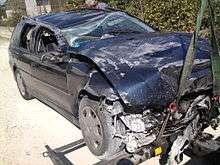Head-on collision
A head-on collision is a traffic collision where the front ends of two vehicles such as cars, trains, ships or planes hit each other when travelling in opposite directions, as opposed to a side collision or rear-end collision.
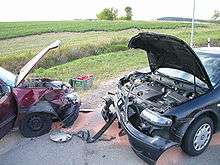
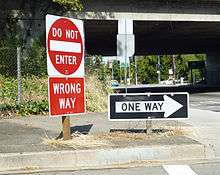
Rail transport
_on_the_Houston_and_Sreaves_Poart_(Shreaveport)_R._R._8_Miles_North_of_Lufkin%2C_Texas_in_1893_(16510749725).jpg)
.jpg)
With railways, a head-on collision occurs most often on a single line railway. This usually means that at least one of the trains has passed a signal at danger, or that a signalman has made a major error. Head-on collisions may also occur at junctions, for similar reasons. In the early days of railroading in the United States, such collisions were quite common and gave to the rise of the term "Cornfield Meet." As time progressed and signalling became more standardized, such accidents became less frequent. Even so, the term still sees some usage in the industry. The origins of the term are not well known, but it is attributed to accidents happening in rural America where farming and cornfields were common. The first known usage of the term was in the mid-19th century.
The distance required for a train to stop is usually greater than the distance that can be seen before the next blind curve, which is why signals and safeworking systems are so important.
List of collisions
Note: if the collision occurs at a station or junction, or trains are travelling in the same direction, then the collision is not a pure head-on collision
| Date | Name | Location | Cause | Deaths | Injuries |
|---|---|---|---|---|---|
| September 10, 1874 | Thorpe rail accident | Thorpe St Andrew, Norfolk, England | Single-line telegraphic working error | 25 | 75 |
| August 7, 1876 | Radstock rail accident | Somerset and Dorset Joint Railway, England | Single-line telegraphic working error | 15 | |
| September 24, 1904 | New Market train wreck | New Market, Tennessee, United States | Engineer error | 56 - 113 | 106 |
| July 9, 1918 | Great Train Wreck of 1918 | Nashville, Tennessee, United States | Human error | 101 | 171 |
| January 26, 1921 | Abermule train collision | Abermule, Montgomeryshire, Wales | Single-line token error | 17 | 36 |
| October 20, 1957 | Yarımburgaz train disaster | Yarımburgaz, Küçükçekmece, İstanbul | Allowing two trains into same occupied block section by signalmen | 95 | 150 |
| November 16, 1960 | Stéblová train disaster | Stéblová, Czechoslovakia | Collision | 118 | 110 |
| February 7, 1969 | Violet Town rail accident | Violet Town, Victoria, Australia | Driver heart attack | 9 | 117 |
| May 27, 1971 | Dahlerau train disaster | Dahlerau, Radevormwald, West Germany | Not determined | 46 | 25 |
| May 4, 1976 | Schiedam train disaster | Near Schiedam, Netherlands | Error by the chief conductor
and the driver of Stoptrein 4116, lack of ATB |
24 | |
| August 28, 1979 | Nijmegen train collision | Between Wijchen and Nijmegen, Netherlands | 8 | 36 | |
| July 25, 1980 | Winsum train collision | Winsum, Groningen | Head-on-collision | 9 | 21 |
| September 11, 1985 | Moimenta-Alcafache train crash | Mangualde, Portugal | Collision | 49 | |
| February 8, 1986 | Hinton train collision | Dalehurst, Alberta, Canada | Locomotive engineer fatigue
Conductor error |
23 | 71 |
| February 17, 1986 | Queronque rail accident | Limache, Marga Marga Province, Chile | Human error | 58+ | 510 |
| October 19, 1987 | 1987 Bintaro train crash | Bintaro, Tangerang, Indonesia | Human error | 156 | ± 300 |
| March 6, 1989 | Glasgow Bellgrove rail crash | Bellgrove, Glasgow, Scotland | Signal Passed At Danger | 2 | |
| July 21, 1991 | Newton (South Lanarkshire) rail accident | Newton, South Lanarkshire, Scotland | Signal Passed At Danger, inadequate junction layout | 4 | 22 |
| October 15, 1994 | Cowden rail crash | Cowden railway station, Kent, England | Signal Passed At Danger | 5 | 13 |
| January 14, 1996 | Hines Hill train collision | Hines Hill, Western Australia | Signal Passed At Danger | 2 | |
| August 12, 1998 | Suonenjoki rail collision | Suonenjoki, Finland | Misinterpretation of signals, possible signal malfunction | 0 | 26 |
| August 2, 1999 | Gaisal train disaster | Gaisal, Uttar Dinajpur, West Bengal, India | Human error | 285 | >300 |
| October 5, 1999 | Ladbroke Grove rail crash | Ladbroke Grove, London, England | Signal Passed At Danger | 31 | 417 |
| January 4, 2000 | Åsta accident | Åsta, Åmot, Norway | 19 | ||
| January 7, 2005 | Crevalcore train crash | Crevalcore, Italy | |||
| October 11, 2006 | Zoufftgen train collision | Zoufftgen, Lorraine, France | Human error | 6 | 20 |
| September 12, 2008 | 2008 Chatsworth train collision | Los Angeles, California, United States | Signal Passed At Danger | 25 | 135 |
| February 15, 2010 | Halle train collision | Buizingen, Halle, Belgium | Running of a red signal | 19 | 171 |
| January 29, 2011 | Hordorf train collision | Hordorf, Saxony-Anhalt, Germany | 10 | 23 | |
| April 21, 2012 | Sloterdijk train collision | Westerpark, Amsterdam, Netherlands | Suspected Signal Passed At Danger | 1 | 116 |
| February 9, 2016 | Bad Aibling rail accident | Bad Aibling, Bavaria, Germany | Signalman's error | 12 | 85 |
| July 12, 2016 | Andria-Corato train collision | Andria, Apulia, Italy | Under investigation; possible human error | 23 | 54 |
| November 15, 2017 | Joo Koon rail accident | Joo Koon MRT station, Singapore | Software-related issue | 0 | 38 |
Sea transport
With shipping, there are two main factors influencing the chance of a head-on collision. Firstly, even with radar and radio, it is difficult to tell what course the opposing ships are following. Secondly, big ships have so much momentum that it is very hard to change course at the last moment.
Road transport
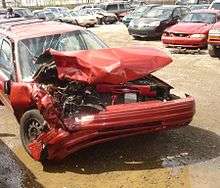
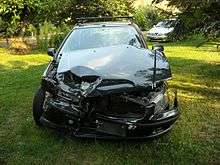
Head-on collisions are an often fatal type of road traffic collision. The NHTSA defines a head-on collision thusly:
Refers To A Collision Where The Front End Of One Vehicle Collides With The Front End Of Another Vehicle While The Two Vehicles Are Traveling In Opposite Directions.[3]
In Canada, in 2017, 6,293 vehicles and 8,891 persons were involved in head-on collision, injuring 5,222 persons and killing 377 other.[4]
U.S. statistics show that in 2005, head-on crashes were only 2.0% of all crashes, yet accounted for 10.1% of U.S. fatal crashes. A common misconception is that this over-representation is because the relative velocity of vehicles travelling in opposite directions is high. While it is true (via Galilean relativity) that a head-on crash between two vehicles traveling at 50 mph is equivalent to a moving vehicle running into a stationary one at 100 mph, it is clear from basic Newtonian Physics that if the stationary vehicle is replaced with a solid wall or other stationary near-immovable object such as a bridge abutment, then the equivalent collision is one in which the moving vehicle is only traveling at 50 mph.,[5] except for the case of a lighter car colliding with a heavier one. The television show MythBusters performed a demonstration of this effect in a 2010 show.[6]
In France, in the years 2017 and 2018, 2563 and 2556 head-on collisions (collision frontales) outside built-up area outside motorways killed 536 and 545 people respectively.[7] They represent about 16% of all the fatalities including the ones on motorways and within built-up area.
In Quebéc head-on collisions are involved in 8% of work related issues, but 23% when two vehicles are involved in rural high speed zone where the maximum speed is greater than 70 km/h (43.5 mph).[8]
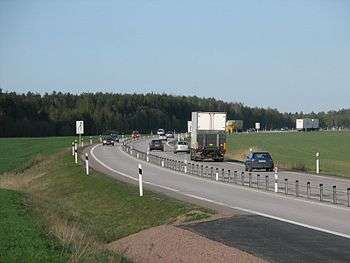
Head-on collisions, sideswipes, and run-off-road crashes all belong to a category of crashes called lane-departure or road-departure crashes. This is because they have similar causes, if different consequences. The driver of a vehicle fails to stay centered in their lane, and either leaves the roadway, or crosses the centerline, possibly resulting in a head-on or sideswipe collision, or, if the vehicle avoids oncoming traffic, a run-off-road crash on the far side of the road.
Preventive measures include traffic signs and road surface markings to help guide drivers through curves, as well as separating opposing lanes of traffic with wide central reservation (or median) and median barriers to prevent crossover incidents. Median barriers are physical barriers between the lanes of traffic, such as concrete barriers or cable barriers. These are actually roadside hazards in their own right, but on high speed roads, the severity of a collision with a median barrier is usually lower than the severity of a head-on crash.
The European Road Assessment Programme's Road Protection Score (RPS) is based on a schedule of detailed road design elements that correspond to each of the four main crash types, including head-on collisions. The Head-on Crash element of the RPS measures how well traffic lanes are separated. Motorways generally have crash protection features in harmony with the high speeds allowed. The Star Rating results show that motorways generally score well with a typical 4-star rating even though their permitted speeds are the highest on the network. But results from Star Rating research in Britain, Germany, the Netherlands and Sweden have shown that there is a pressing need to find better median (central reservation), run-off and junction protection at reasonable cost on single carriageway roads.
Another form of head-on crash is the wrong-way entry crash, where a driver on a surface road turns onto an off-ramp from a motorway or freeway, instead of the on-ramp. They can also happen on divided arterials if a driver turns into the wrong side of the road. Considerable importance is placed on designing ramp terminals and intersections to prevent these incidents. This often takes to form of special signage at freeway off-ramps to discourage drivers from going the wrong way. Section 2B.41 of the Manual on Uniform Traffic Control Devices describes how such signs should be placed on American highways.
Head on collision does not need a car to be involved, for instance, the Puisseguin road crash was between a truck and a coach.
Sideswipe collisions
Sideswipe collisions are where the sides of two vehicles travelling in the same or opposite directions touch. They differ from head-on collisions only in that one vehicle impacts the side of the other vehicle rather than the front. Severity is usually lower than a head-on collision, since it tends to be a glancing blow rather than a direct impact. However, loss of control of either vehicle can have unpredictable effects and secondary crashes can dramatically increase the expected crash severity.
References
- California Department of Transportation (2019). California Manual on Uniform Traffic Control Devices (Section 2B.41). Sacramento: State of California. pp. 162–165. Retrieved 28 December 2019.
- Railroad Gazette April 5, 1895 p.214
- https://www-fars.nhtsa.dot.gov/Help/Terms.aspx
- http://wwwapps2.tc.gc.ca/Saf-Sec-Sur/7/NCDB-BNDC/p.aspx?i=1157&l=en#o18
- "PhysicsLab: Head-on Collisions 2". Retrieved 9 May 2012.
- "MythBusters: Mythssion Control – Head-on Collision Experiment". Archived from the original on 2010-05-04. Retrieved 6 May 2010.
- ONISR source
- https://medias.irsst.qc.ca/videos/1403_ps_cr_HD_0099-4460_fr_pdf.pdf
- https://ec.europa.eu/transport/road_safety/sites/roadsafety/files/pdf/20151210_1_sweden.pdf
| Look up head-on collision or cornfield meet in Wiktionary, the free dictionary. |

